
2006 – Winners of the 2nd Annual Archie League Medal of Safety Awards, honored on Jan. 30, 2006 at the Hyatt Regency Capitol Hill in Washington, D.C.:
Alaskan Region: Bret Brown, Tom Eisenmayer, and Mike Moravec, Anchorage Center
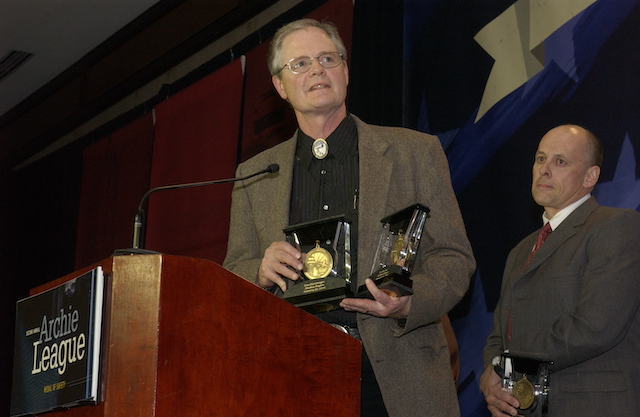
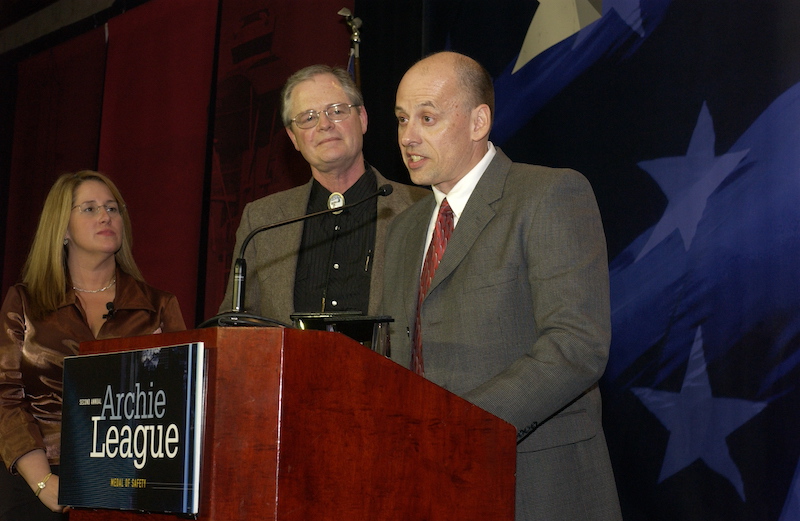
When the pilot of a Cessna 172 Skyhawk inadvertently flew into Instrument Flight Rules (IFR) conditions – he was not IFR-qualified – and found himself lost in the poor weather, three calm, alert and dedicated air traffic controllers from Anchorage Center came to the rescue and put their skills to work. They were aided significantly by a pilot who showed a remarkable willingness to participate and provided the controllers with detailed reports that gave them literally a birds’ eye view of the emergency situation until its safe conclusion.
Controller Mike Moravec was working at the center’s sector R6 position when a phone call came in from the Kenai flight service station. They reported that they were assisting the pilot of the Cessna, who was in trouble in the clouds and needed immediate assistance. Immediately, Moravec started to gather information. The Cessna was on a DF steer at 7,900 feet, somewhere in the vicinity of Cantwell, Alaska (located between Anchorage and Fairbanks). A DF steer, which means direction-finding guidance, is a heading which, if followed, will lead the aircraft to a predetermined point, such as the radio direction-finding station or an airport. DF guidance is given to aircraft in distress or to other aircraft that request the service.
Moravec asked for assistance. Bret Brown had just finished working sector nine and immediately plugged in to sector R6 to assist. Realizing that this would be a situation that required their total attention, sector R5 controller Tom Eisenmayer took control of switching other traffic in sector R6 to a different frequency. Moravec kept Anchorage Terminal Radar Approach Control (TRACON) aware of the situation and had them switch any aircraft bound for sector R6 to other sectors’ frequencies. This made it easier for them to focus on the emergency.
When the Cessna called Anchorage Center, Brown took control of the situation by getting the position, altitude, heading, fuel and other information. Brown kept the pilot calm and aware of the plan to get him to Visual Flight Rules (VFR) weather conditions. He also learned that the pilot’s wife, who was on board, could aid in some cockpit duties, thus freeing up the pilot to maintain concentration on straight and level flight. Meanwhile, there was another aircraft that was on an IFR flight plan in the area and Brown requested his assistance. The pilot of this aircraft, Jeff Helmericks, was instrumental in finding VFR weather and provided many reports on conditions. He delayed in the area until the Cessna descended into the VFR area and then followed him to the Willow, Alaska, airport, which is located between Cantwell and Anchorage. Helmericks relayed his eyewitness report of the safe landing of the Cessna to sector R6.
It was the culmination of a remarkable team effort. Brown contributed outstanding work in gathering information, keeping the pilot pointed in the right direction and keeping the situation calm and under control. His pilot knowledge and local familiarity of the area allowed a successful outcome to the situation. Moravec came through with a skillful effort in coordinating information and managing the traffic in the sector. Eisenmayer took on additional traffic duties and kept things running smoothly for sector R6. And of course, Helmericks was in the right place at the right time to help ensure a safe outcome.
Rick Thompson, Alaskan Regional Vice President:
“I’ve known all three of these men for many years. These highly seasoned controllers worked together in a complicated situation, using their years of experience to talk a lost pilot to the ground and ensure a successful outcome. Alaska’s terrain is often remote and unforgiving, thus increasing the importance of controller skills in providing a pilot with expeditious service and the ability to succinctly describe available options. Their years of experience and knowledge came to play as they kept the pilot calm while simultaneously taking on more traffic and ensuring things continued to go smoothly in their sector I am proud to represent these members and they are most deserving of this truly special honor. They exemplify everything that makes me proud to be an air traffic controller and I wish them the best.”
Read transcript of event highlights.
Central Region: Mark Goldstein, Wichita Tower/TRACON
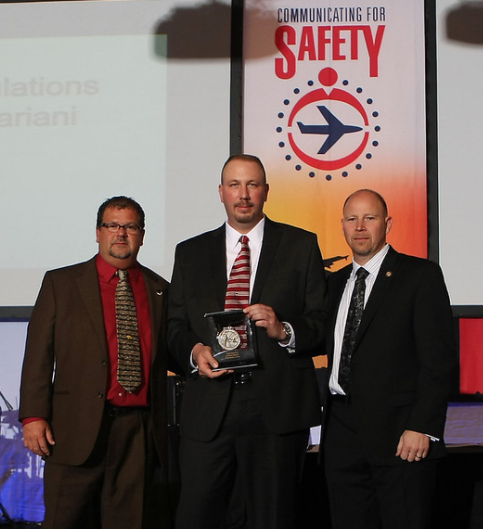
If the name of the award winner atop this page sounds familiar, it should.
Mark Goldstein won the inaugural Archie League Medal of Safety Award for the Central Region in 2004. He initiated his own investigation of a landing aircraft’s report of foreign object debris (FOD) on the runway, eventually finding out which flight had lost the parts and working to reach the pilots, who safely landed the plane after declaring an emergency. It was Goldstein’s conscientiousness and also his experience as both an air traffic controller and a pilot that helped him in this situation and has also served his facility well by making numerous suggestions to pilots in distress and helping many controllers who needed assistance.
On Nov. 18, 2005, Goldstein’s experience was put to good use again.
Goldstein was working the tower’s local control position. A Piper Cherokee PA32 was inbound to Runway 19 Right from the northwest. Due to heavy traffic on both runways, Goldstein instructed the Cherokee to make a 360-degree turn and follow the traffic on short final approach to Runway 19 Left.
While listening to the pilot read back the landing clearance, acknowledging the instruction, Goldstein could hear an alarm going off in the background. As a pilot, he knew the familiar sound almost instantly. It was the plane’s landing gear alarm. Goldstein immediately contacted the pilot and advised him to check if the landing gear was down. It was not. The pilot had forgotten to lower the gear due to his high workload in setting up for the landing.
With the gear safely down, the pilot soon landed the Cherokee without incident. He then radioed the tower and thanked Goldstein for his assistance.
“Had it not been for Mark and his experience, the plane would have landed without its landing gear and who knows what could have happened then,” said Wichita Tower NATCA facility representative Pat Pelkowski.
John Tune, Central Region Vice President:
“Mark Goldstein has done it again. With a pilot hurtling towards the runway with his landing gear up, Mark’s quick thinking and attention to detail made the difference between a safe landing and potential catastrophe. Controllers have a great deal of responsibility when they strap on their headsets each day, but saving lives is their sacred trust. Mark’s expertise in the tower prevented this incident from making front page news. Controllers like him are a great example of the difference NATCA members make in the lives of air travelers each and every day. Mark is a fantastic controller and winning this award is a tremendous accomplishment representative of the fantastic members working traffic every day in NATCA’s Central Region.”
Read the transcript of the event highlights.
Eastern Region: Stephen Barringer, John Bradley, Adam Cohen, Mark Franklin, Peter Grebenschikoff, and Randy Trainor, Atlantic City Tower/TRACON
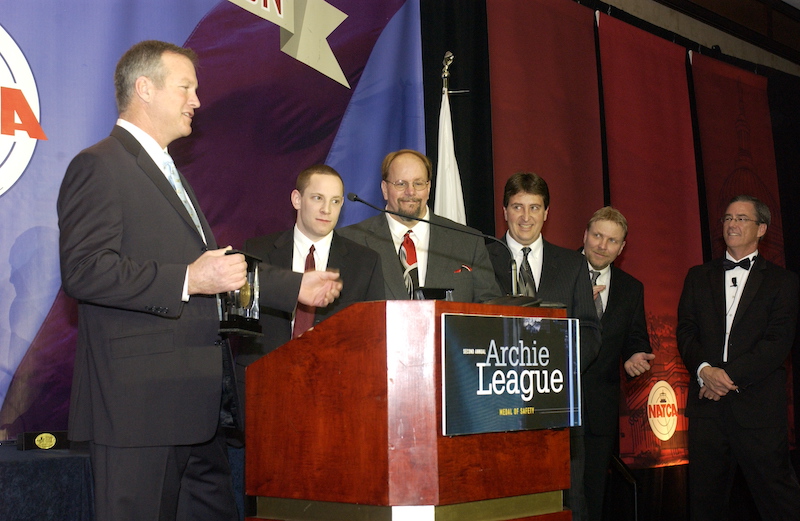
To an outsider, the service of air traffic control would appear to involve just two people at any one time – a single pilot on one end of the radio and a single air traffic controller on the other. But the essence of a successful air traffic control operation is built on teamwork, especially when situations arise involving aircraft in distress. A crew of five air traffic controllers, led by a controller-in-charge, were working during the start of the Fourth of July weekend last year at Atlantic City, N.J., Tower. They were called upon to respond to not only one, but two events within 30 minutes of each other.
The first involved a Beechcraft Bonanza 36, a single-piston aircraft. The weather reported in the area was low instrument flight rules (IFR) conditions. The Bonanza took off from Ocean City, N.J., Municipal Airport – which lies seven miles south of Atlantic City International Airport – headed for Glens Falls, N.Y. The pilot established intermittent radio communications with John Bradley, the controller working the South Arrival Radar position. Bradley issued a climb to 7,000 feet and a northbound heading. Bradley then observed the aircraft descending and turning east. When asked, the pilot was not able to communicate his intentions due to a radio problem.
The Bonanza appeared to have problems maintaining a heading and altitude. In broken transmissions, the pilot informed Bradley that his autopilot was malfunctioning and he was unable to disengage it. The malfunction caused the aircraft to pitch up uncontrollably. Immediately, word reached the tower to stop departures. With the erratic flying of this aircraft, the Bonanza found its way directly into Atlantic City’s departure path, making it a threat to all departing traffic. Controller Peter Grebenschikoff then opened a North Arrival Radar (NAR) position to relieve Bradley of other aircraft on the radio frequency, making it easier for him to focus on the Bonanza. Grebenschikoff was able to assist with information gathering from pilot reports and weather stations and learned that cloud tops were reported at 4,500 feet. Bradley suggested to the Bonanza pilot that he try to climb to get on top of the clouds so that he might be able to work out his aircraft’s difficulties.
The pilot climbed, reported on top of the cloud layer at 4,500 feet and finally was able to disengage the autopilot. He then continued the flight and was handed off to the next facility without further incident.
Soon after, another situation arose that required quick action from the Atlantic City team. An F-18 military jet en route to McGuire Air Force Base at Fort Dix in New Jersey, flying through Atlantic City’s airspace, declared a fuel emergency and requested vectors to the nearest airport. Randy Trainor, working the clearance delivery position, obtained weather reports from nearby airports. The pilot requested vectors for an Airport Surveillance Radar (ASR) approach to Atlantic City. Bradley, still working the South Arrival position, then handed the aircraft off to Stephen Barringer, working the East Arrival Radar position. Barringer conducted the ASR approach.
Traffic was busy. Both Bradley and Grebenschikoff had to move other aircraft to allow the F-18 an expedited handling to the airport. Meanwhile, local Controller Adam Cohen ensured that no other tower traffic affected the safe arrival, while ground controller Mark Franklin coordinated the airport’s emergency responders. The aircraft was able to complete the approach safely and landed without further incident.
Said Atlantic City Tower NATCA Facility Representative Keith Johnson about the events: “It is a credit to all personnel involved that both of these situations ended without incident. The air traffic teamwork displayed ensured that the best possible service was provided to both users. The controller-in-charge who was responsible for the operation ensured that he had the right people, in the right position, at the right time.”
Phil Barbarello, Eastern Regional Vice President:
“This save can only be described as the essence of a team effort. Six dedicated controllers concerned only with the safety of the flying public made not one, but two back-to-back saves in the span of a half hour. After the first plane experienced mechanical problems upon takeoff, this team of professionals worked together seamlessly to clear the runways, stop all departures, and make sure emergency personnel were mobilized while communicating with the pilot to get him back on the ground in a safe and expeditious manner. Not 30 minutes later, a second aircraft declared a fuel emergency. Once again, this team jumped into action exactly as they had done earlier to get the pilot on the ground safely and calmly. The actions of our controllers in Atlantic City are a testament to the preparedness and ability of members throughout the Eastern Region and the country. These six controllers demonstrate the kind of disciplined teamwork that averts disaster in a very fast-moving and complex airspace system. This kind of focus and excellent response is the hallmark of professionals always poised to make the difference in a life and death scenario. I am proud to represent these fine NATCA members.”
View a transcript of event highlights.
Great Lakes Region: Kevin Rojek, Chicago Midway Tower
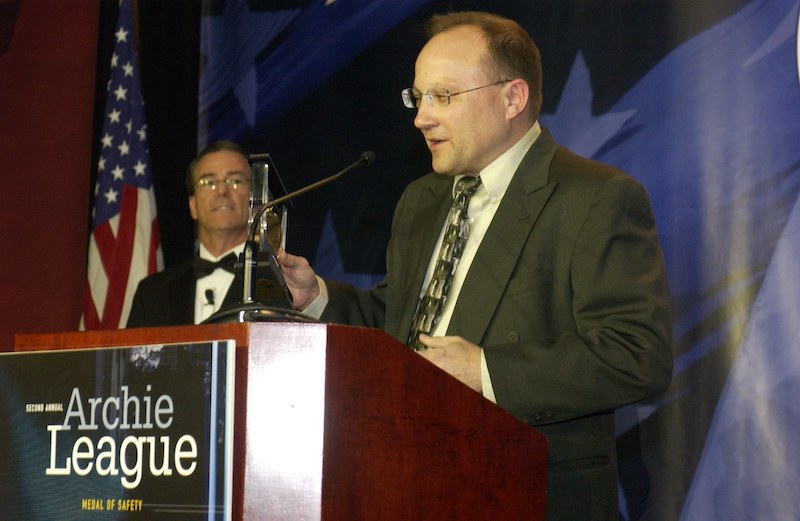
Chicago Municipal Airport, or “Munie,” as early pilots knew it, earned the title of “World’s Busiest,” after serving more than 100,000 passengers in 1932, just five years after it opened. In 1949, the Chicago City Council changed the airport’s name to Chicago Midway Airport in honor of the Battle of Midway in World War II. But while Chicago’s larger airport, O’Hare International, claimed the “World’s Busiest” title in recent decades, Midway has grown as well, using every square inch of its cramped quarters in a densely populated neighborhood 10 miles south of downtown Chicago.
Midway Tower controllers oversee well more than a quarter of a million operations annually – earning the airport’s nickname of “World’s Busiest Mile” – and now more than ever must remain on their toes to keep the tightly choreographed traffic flows safe and efficient.
Such was the case on the morning of August 4, 2005. Controllers were using Runways 22 Left (22L) and 31 Center (31C), which cross in the middle to form one of the most famous runway layouts in aviation. On this day, in Instrument Landing System (ILS) conditions, controllers were using the familiar circling approach to 22L. It’s a very demanding approach considering the mix of aircraft that circle because there is no straight-in approach due to the proximity of the downtown Chicago skyscrapers.
The local controller in the tower instructed United Airlines Flight 1429, an Airbus 320, to taxi into position and hold on runway 31C. The same controller then told a taxiing aircraft to hold short of 31C before clearing an Exec Jet for takeoff off on Runway 22L. Moments later, the controller made contact with Southwest Airlines Flight 1486, a Boeing 737, telling the pilot to taxi into position and hold on 22L. Southwest 1486 was tightly sandwiched between the departing Exec Jet and another Southwest flight on final approach to 22L.
With United 1429 still holding on 31C, the local controller gave Southwest 1486 its clearance for an immediate takeoff from 22L. The Southwest 1486 pilot acknowledged his takeoff clearance. Then, just as the local controller moved on to issue a landing clearance to another aircraft, Kevin Rojek, who was working the ground control position, alertly noticed that the pilot of United 1429 – after apparently believing the takeoff clearance given to Southwest 1486 was meant for him – had begun his takeoff roll. Both jets were rolling down crossing runways and on a collision course to meet at the intersection.
But upon hearing Rojek say “rolling,” the local controller turned to see the aircraft and immediately got on the radio. With his voice rising, he sternly said, “United stop! United stop!” United 1429 stopped approximately 1,000 feet short of Runway 22L. After Southwest 1486 rolled through the intersection and took off, United 1429 crossed 22L, taxied back around the tarmac as his brakes cooled and eventually made its way back to Runway 31C for departure.
Said Midway NATCA Facility Representative Ron Adamski: “Kevin’s quick action and alertness allowed the local controller to stop the United aircraft prior to a meeting at the intersection with the Southwest jet. Kevin’s alertness should be recognized for saving a potential intersection collision.”
As Southwest 1486 began his ascent, the local controller gave him one more instruction, handing him off to Chicago Terminal Radar Approach Control: “Southwest 1486, contact departure.” The Southwest pilot, cognizant of the disaster averted when the controller stopped United 1429’s departure roll, replied: “Fourteen eighty six, switching. See ya. Thank you.”
Pat Forrey, Great Lakes Region Vice President:
“Preventing collisions on the ground is one of the most important responsibilities of any tower controller. Kevin’s actions at Midway Airport exemplify his ability to look at the ‘big picture’ and understand what is happening around him at all times. He wasn’t just attentive to what was happening in front of him; his instincts and attention to detail prompted him to notice an overwhelmed controller and potential disaster brewing in the form of a runway collision. Kevin’s alertness and quick action allowed his colleague to prevent two aircraft from coming together at an intersection. It is the skill and performance of controllers like Kevin that make us the best at what we do. His professionalism and technical expertise provides an example that all controllers can follow. I am proud to represent Kevin and join with my fellow controllers in the Great Lakes region in congratulating him for making a difference in air traffic safety.”
Read a transcript of the event highlights.
New England Region: James Sawyer and Kevin Winn, Boston Tower
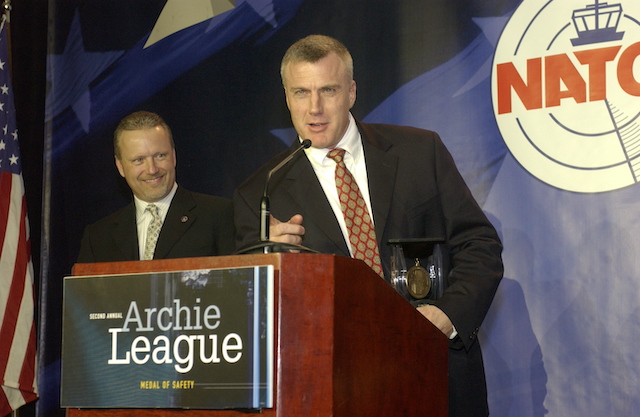
The intricacies of Boston’s Logan Airport are well known to both pilots and controllers and others who operate various equipment around the tarmac. It’s a small layout, with many crossings of taxiways and runways. Extreme focus is essential at all times, because even the most innocent of movements can quickly turn into a potential incident.
Such was the case on the morning of Aug. 8, 2005. Logan Tower controllers were using Runways 22 Left and 27 for landing and Runway 22 Right for departures. The ground controller on duty was Kevin Winn. His veteran colleague on local control was James Sawyer. The simultaneous actions of both men involving the same aircraft helped prevent a potential disaster.
A Federal Express jet, an Airbus 300, operated by a non-pilot – likely a mechanic – requested taxi instructions from the FedEx ramp to perform a maintenance procedure called a high-powered run-up. Winn instructed the aircraft to proceed via taxiway kilo and hold short of Taxiway Charlie. Charlie turns right 90 degrees off kilo and intersects Runway 22R, so Winn gave the FedEx some very important instructions.
Winn told the FedEx to make the right turn onto taxiway Charlie and clearly added that the jet should hold short of Runway 22R. The jet’s operator acknowledged the transmission, but then proceeded to do the very thing he was instructed to avoid – cross Runway 22R. Winn immediately caught it: “FedEx 661 STOP!” He then told the aircraft to hold short of Runway 22L and pointed out the operator’s error, saying, “FedEx 661, uh, you just crossed Runway 22 Right on your own, you know that.” The operator acknowledged and said he didn’t realize the mistake until he had found himself halfway across the runway.
Winn, confident that FedEx 661 was not going to proceed any further and risk crossing 22L then instructed the aircraft to change frequency, and monitor the tower’s local control. But by then, Sawyer had already tried and failed to reach FedEx661 as it approached Runway 22R and did not look like it was going to stop short. Sawyer was forced to make some quick decisions regarding a JetBlue flight off 22R, which he had moments earlier cleared for takeoff. But upon failing to reach the FedEx operator, Sawyer immediately canceled JetBlue’s takeoff clearance and averted a serious incident.
“These controllers are very deserving of this award because of their quick reaction,” Boston Tower NATCA Facility Representative Tom Coronite said. “Because he was scanning the operating area, James saw the FedEx aircraft moving fast and, even though that aircraft was not his responsibility, he took immediate action. As FedEx was not on his frequency, he quickly went to the JetBlue pilot and canceled his takeoff clearance. Otherwise, the FedEx and the JetBlue may have collided at the Runway 22 Right and the Taxiway Charlie (C) intersection.”
Mike Blake, New England Region Vice President:
“Jim Sawyer is the consummate professional. Some may mistake his intense demeanor as harsh, but let me assure you, his job at Logan is complex, and those who choose to work there better bring their ‘A Game.’ He has been a NATCA activist for many years and is presently the legislative coordinator for Maine. Jim has five children, one of whom is performing his second tour of duty in the Middle East as a U.S. Marine. Sacrifice and professionalism are Jim’s legacies. Kevin Winn is another of Boston Logan’s finest. He is passionate about runway safety and expects those who visit this complex facility to be prepared for its extremely fast pace. He has a wonderful sense of humor, and cares for his fellow controllers. One of his well known lines in the tower cab is ‘What’s wrong with the TRACON?’ He is a lighthearted professional who leaves his fellow workers smiling.”
Read a transcript of event highlights.
Northwest Mountain Region: Randy Neu, Pueblo Tower/TRACON
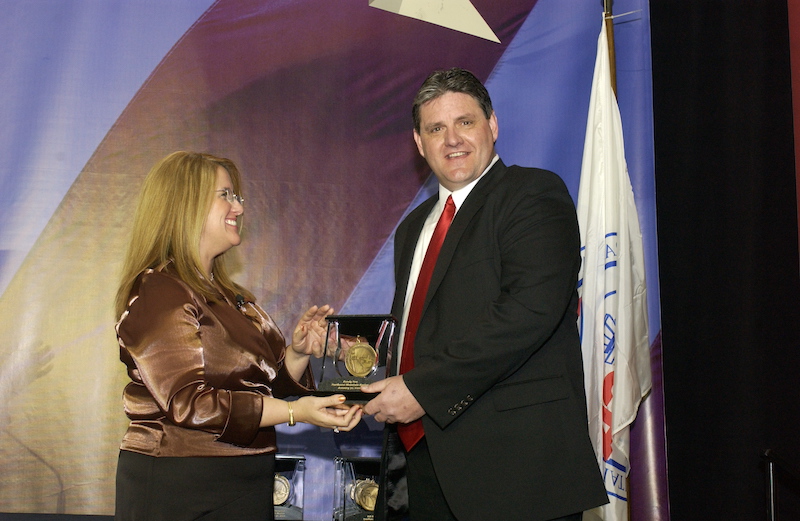
On the morning of Memorial Day last year, a calm, confident, soothing voice, belonging to Pueblo Tower Controller Randy Neu, was the difference between life and death.
Because of poor weather, the airport was in Instrument Flight Rules (IFR) conditions, utilizing an Instrument Landing System (ILS) approach to Runway 8 Left. It was approximately 10 a.m. local time and Neu and his colleagues were handling a normal traffic load. One of the aircraft, a Cessna 182, piloted by Dan Gilbert, with his wife on board, was making his first ILS approach. The aircraft was on short final, within five miles of the runway, when he suddenly called the tower and advised Neu – who was working the north radar/local control position – that he missed the approach. As Gilbert began his climb-out, he radioed the tower and complained to Neu of suffering from spatial disorientation – vertigo. He was in serious trouble.
Many extensive studies have demonstrated conclusively that spatial disorientation in the clouds must be reversed and righted normally within three minutes, otherwise the flight normally spins out of control, ending in tragedy. If not the most serious of flight situations, it is certainly among the most common to end in disaster.
Phil Murtha was the controller-in-charge in the tower on this morning. He monitored the position and stood by on the surveillance radar position. “Randy quickly and professionally took control,” Murtha said. Hearing the distress in the pilot’s voice, Neu elected first to guide Gilbert immediately out of the clouds, an action that required a number of simultaneous talents. First, he had to issue instructions that were easy to follow because statistics indicate that he wouldn’t have a second chance. Second, he had to have the presence of mind to ascertain where to guide Gilbert to get him out of the clouds the fastest. And third, he had to do it in such a way as to instill confidence in the pilot who, naturally, would have been in extreme distress and sensory overload.
Neu vectored the aircraft back into position to make a second attempt at landing and established Gilbert on the localizer – the ILS navigational aid – before he re-entered the clouds. Gilbert completed the approach and landed safely.
A couple of hours later, Gilbert and his wife came to the control tower and spoke with FAA Operations Supervisor James Kadrmas, who was advised of what had happened, received their thanks to pass along to Neu, and was also told that if it hadn’t been for Neu’s calm and assuring instructions, Gilbert probably would not have made it down safely. Gilbert’s wife told Kadrmas, “The controller saved our lives. Thank you!”
Kadrmas wrote a Letter of Commendation to Neu, saying, “The continuing praise and sincere gratitude from (the pilot) and his wife is what I wish to commend you for. Your performance reflects well on you, your facility and the FAA. Thank you again.” In a separate memo on the incident, Kadrmas wrote, “Randy’s handling of the situation was one of the calmest emergencies I have listened to in my 27 years of service. His putting (the aircraft) on top and setting him up for the ILS on top was superb.”
Added Murtha: “When Gilbert and his wife visited the tower, could not stop praising the controller that worked him, and his wife chimed in that she ‘thought they were going to die.’ I monitored the situation from beginning to end and, I must say, I have not ever heard a more professional performance. I’m a pilot and a controller for 34 years and it made me proud to witness this save.
Carol Branaman, Northwest Mountain Region Vice President:
“The sequence of events and the kind of pressure Randy Neu was under on May 30, 2005, is easily worthy of a Hollywood script. But as we often learn, our real heroes lead ordinary lives in small towns and cities all across our country. Randy is one such hero, and a pilot and his wife in Pueblo, Colo., are alive today because he brought his considerable talents to bear at their time of need while ‘just doing his job.’ But it takes more than training to respond as quickly and with such insight and steely confidence as Randy demonstrated. It takes something special. And Randy is all the more special because of something that happened to him only a few months before this remarkable save. Earlier in the year, he was working a flight that disappeared from radar without warning. As it turned out, the aircraft crashed, killing eight people. After a long, harrowing, and difficult investigation, he was found blameless but, as the controller who last spoke to the pilot, Randy was extremely shaken. Controllers take it personally when things happen on their watch, even things that are beyond their control. And so it is all the more remarkable that Randy was able to put that memory away, knowing the difference between life and death was quite likely in his hands. Randy Neu is one of the reasons why our citizens sleep soundly at night, knowing their air traffic controllers are among the best, the brightest, and the most caring our country has to offer.”
Read transcript of event highlights.
Southern Region: Jesse Fisher, Miami Tower
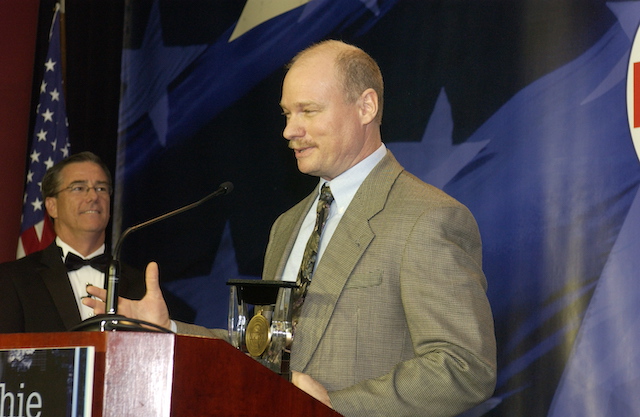
The scenario had all the makings of a disaster. It was dark. Traffic volume was heavy and complex. The local control positions inside Miami Tower were combined. The radio frequency was congested. The weather was marginal. Visibility was poor. And the airport’s Airport Movement Area Safety System was in limited mode, meaning it was not providing controllers with aural or visual alarms to signal potential runway incidents.
Controllers in the tower were using Runways 26 Right (26R) and 27 for arrivals, using staggered instrument approaches, and departing on Runways 26 Left (26L) and 27. Rain obscured both the movement area and final approach courses. Veteran tower Controller Jesse Fisher was working the Local Control North (LCN) position, combined with the Local Control South position.
A Lockheed L329 Jetstar was on approach to Runway 26R. The pilot checked in with Fisher on the LCN frequency and Fisher cleared him to land on Runway 26R. The pilot acknowledged the clearance and subsequently reported that the runway was in sight.
Meanwhile. American Airlines Flight 2104, a Boeing 737, was taxied into position and holding on Runway 26L, awaiting takeoff clearance, due to in-trail separation with traffic departing Runway 27, and traffic crossing the runway. Additionally, American Airlines Flight 1917, a Boeing 757, which had just arrived on Runway 26R, was instructed to cross Runway 26L and was advised that traffic (American 2104) was holding in position.
As Fisher scanned the movement area and the final approach courses, he saw the Jetstar on short final approach, at approximately 200 feet off the ground, lined up with the wrong runway – 26L instead of 26R – with American 2104 holding in position and American 1917 crossing the runway downfield.
Fisher immediately instructed the Jetstar to execute a go-around and the pilot complied. He appeared to overfly American 2104 by approximately 100 feet and American 1917 by about 400 feet.
Upon hearing and seeing what was happening, the pilot of American 1917 keyed the radio microphone and uttered an expletive. Shortly thereafter, an unidentified aircraft waiting in line for departure off Runway 26L keyed the mike and said, “Good job, tower!” Another unidentified aircraft waiting in line for departure then transmitted, “Nice save, tower!” When American 2104 was cleared for takeoff, the pilot’s reply was, “Hey, a huge thanks from us.”
Fisher’s quick instruction to the Jetstar pilot was even more important considering that Runway 26L has no displaced threshold, meaning the distance between where American 2104 was holding in position and the point where the Jetstar would have touched down is indiscernible.
“One of the key elements that make Jesse’s actions so outstanding is the fact that Runway 26R and 26L are in such close proximity, with only 800 feet between the center lines,” Miami Tower NATCA Facility Representative Jim Marinitti said.
“Additionally, when you factor in that the tower is located on the opposite side of the airport from the west final approach courses – over two miles away – and that the arrival aircraft appeared to be on the correct final until very close to the airport, it makes it that much more remarkable that Jesse was able to identify this pilot error and take action in time to prevent a catastrophe at night with limited visibility.”
Fisher has worked at Miami Tower since 1991. Adds Marinitti: “It is not a cliché to say that an untold number of passengers arrived home safely on this day due to, but completely unaware of, Jesse’s outstanding situational awareness and heroics on the job. Jesse’s valiant performance truly exemplifies what makes our aviation system the safest in – and the envy of – the world.”
Andy Cantwell, Southern Region Vice President:
“I have personally known Jesse for 15 years and have always considered him to be the consummate professional. On March 18, Jesse once again demonstrated his professionalism and expertise. His attention to detail and quick reactions prevented a foreign general aviation aircraft from landing on a runway that was occupied by a B737 awaiting a takeoff clearance and a B757 crossing the runway downfield. On that night, Jesse was working combined Local Control positions during a period of heavy traffic and marginal weather conditions. The centerlines of Runways 26 left and right are separated by only 800 feet. The runway threshold is approximately two miles away from the tower and it is difficult to determine if arriving aircraft are lined up for the correct runway during daylight and good weather conditions. Fortunately, Jesse did notice that the arriving aircraft was lined up with the wrong runway and quickly issued instructions that prevented a major disaster. In addition to darkness and poor weather conditions, the Airport Movement Area Safety System (AMASS), was operating in limited mode and did not provide any aural or visual alarms of the impending disaster Having worked at MIA for over 24 years, I am intimately aware of just how remarkable Jesse’s actions were on that night. The fact that several pilots commented on the situation means they were also aware that Jesse averted a deadly situation. Jesse believes he was simply doing his job. He did his job perfectly on that night.”
View transcript of event highlights.
Southern Region: Barry Thompson, Louisville-Standiford Tower/TRACON
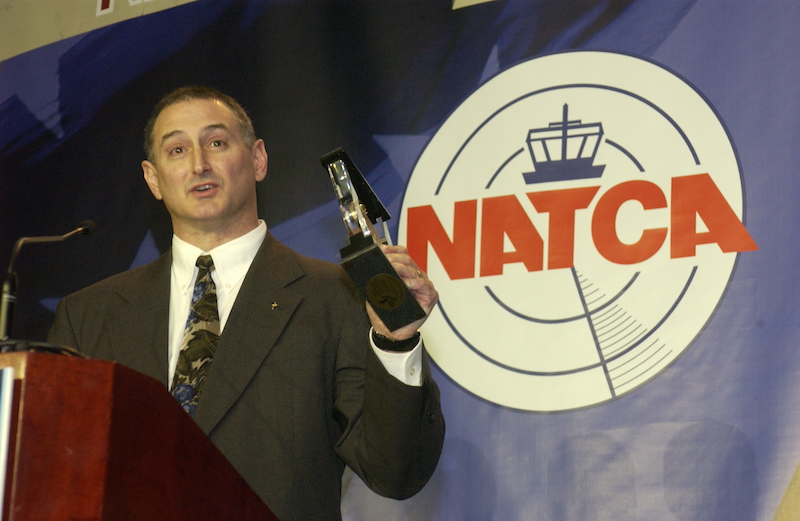
As every radar controller knows, an emergency situation with a flight in trouble is as close as your next radio transmission. On Dec. 1, Controller Barry Thompson, working in the Terminal Radar Approach Control room at Louisville Standiford Tower, found himself as the lifeline for a lost and very panicked pilot of a small plane.
TRACON Supervisor Keith Buckner received a call from a fixed base operator at Clark County Airport, located in southern Indiana, across the Ohio River from Louisville. The FBO had received a distress call from one of its pilots, Charles Moore, who was flying a Cessna 150. The FBO asked for assistance from Louisville Approach. Buckner gave the FBO the frequency of the TRACON’s final control position, which was manned by Thompson. Soon, the call came in from Moore, whose call sign was N45563. Communication was established and Thompson immediately went to work to gather information and pinpoint Moore’s location.
Thompson first asked Moore whether his altitude was 700 feet. There was no answer. So Thompson tried again. And again. This would emerge as a frustrating part of this emergency event, the inability of the pilot to consistently and effectively communicate with Thompson, either due to technical difficulties or the challenges faced by Moore in his panicked state as he tried to find his way. As Thompson tried to confirm Moore’s altitude, he next heard a chilling transmission:
“I need some help, man. I’m afraid. Help me.”
Thompson tried to reach Moore to get him to repeat what he said and calm him down. Instead, Moore made a garbled transmission that Thompson sought to have him clarify, only to be met by more silence. Fortunately, a United Parcel Service pilot, listening on the same frequency, understood Moore and relayed to Thompson that the Cessna pilot needed a heading and was looking for some help.
Thompson then began the process – about 15 minutes long – of trying to help Moore find his way to Clark County Airport. Thompson’s voice was a calming effect, staying cool and steady. By this point, Buckner had coordinated to get all other aircraft off of Thompson’s frequency so that he could focus his attention and energies solely on Moore’s situation. It wasn’t just directional problems that Moore was battling. Moore said that he came close to stalling his Cessna.
Thompson asked Moore if he was at 900 feet, as shown by radar. He was. Thompson then asked Moore to try and climb to 2,000 feet.
A few minutes later, Moore had descended back down to about 1,200 feet. Thompson asked if he could climb up a bit, but Moore said he was afraid to stall, so he stayed at that altitude. Thompson then asked Moore if he preferred to land at Bowman Field, in Louisville, or Clark County Airport. Replied Moore: “Clark County. I want to get back home.”
Thompson assured Moore with his words and his information. “They’re going to turn the lights up all the way for you. The airport is at your 12 o’clock and a half a mile.”
Finally, Moore saw the airport and landed safely. Once on the ground, he was deeply appreciative to Thompson and the facility for saving him, saying, “I appreciate the help. Have a good holiday.”
“Sir, you too,” came the reply from Thompson.
Said Louisville Tower NATCA Facility Representative Jeff Gilde: “Barry’s professionalism in this very tense situation was above and beyond the call of duty. He saved this pilot’s life.”
Andy Cantwell, Southern Region Vice President:
“I am thrilled and honored to salute Barry Thompson as our region’s co-winner of this year’s Archie League Medal of Safety. I cannot think of a more deserving candidate. This honor is a wonderful tribute to a highly skilled and talented veteran controller and also a dedicated NATCA member. Barry is a charter member of NATCA. Before moving to Louisville, he worked at Mobile, Ala., Tower and served as the facility’s secretary, treasurer and also vice president from 1993 to 1995. At Louisville Standiford Tower, Barry served as the local’s vice president from 2000 to 2002. Barry’s performance on Dec. 1 was outstanding in every way. Very few situations are as challenging for a controller as a lost pilot. And this individual was in a state of panic, to say the least. He was scared and needed help fast. Barry threw this man a lifeline and saved the day by keeping his cool, exhibiting professionalism and patience as the transmissions came back garbled and staggered at times and providing life-saving guidance for the pilot to find his way back home to the safety of his airport.”
Southwest Region: Bill Buvens, Dallas-Fort Worth TRACON
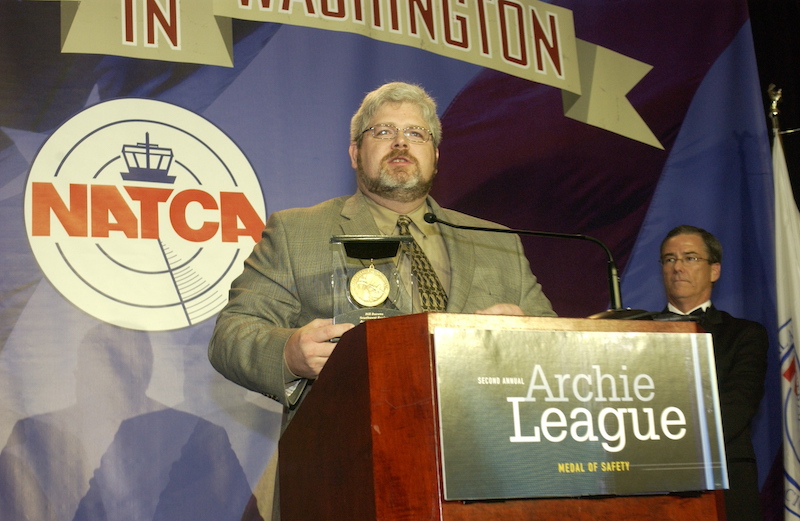
An aircraft lined up to land on the wrong runway at a busy airport like Dallas-Fort Worth International is a fairly rare event, especially in poor weather conditions, when jets are using their Instrument Landing System for precise approaches. But when it occurs, it takes the expert skill, focus and dedication of Terminal Radar Approach Controllers to catch it and then correct it.
On the evening of June 22, Controller Bill Buvens’s exceptional focus was put to the test. Evening had fallen on DFW and the weather was turning worse, with low clouds and poor visibility. The team of controllers at DFW TRACON were putting arriving aircraft on triple simultaneous, ILS approach paths, using Runways 17 Left, 17 Center and 18 Right for landing.
Buvens was working the Final Monitor 2 position, responsible for the final approach into Runway 17C, which sits between Runways 17L and 18R. American Airlines Flight 599 was cleared for an ILS approach to 17C and switched to the DFW Tower radio frequency, as required. Tower controllers cleared the jet to land on 17C.
Buvens, monitoring the tower frequency, heard a controller working the Local East position taxi a jet into position and hold on Runway 17R, which was being used for departures. Then, Buvens, monitoring the approach, noticed that American 599, a Boeing 757 was a little right of the 17C centerline, but still within the confines of the approach. But as the aircraft got closer, it appeared he was actually lined up on Runway 17R. With the aircraft just two miles from the threshold and a jet holding on 17R, Buvens immediately called up to the DFW tower, reaching the Local East controller, and reported that American 599 was lined up on 17R.
The Local East controller asked American 599 to verify he was lined up on 17C, to which the pilot replied, “Uh, no… but we’ll side step over to 17C. We have the airport in sight.” This was when the plane was less than one mile from the runway, or about 15 seconds from possibly landing on top of the plane holding in position on 17R.
The Local East controller then called Buvens to say, “Nice job.” A fellow controller at DFW TRACON told a supervisor about what had happened and Buvens was recommended for a time-off award. In justifying the award, local Federal Aviation Administration officials wrote, “Mr. Buvens is commended for his attention to duty, and going above and beyond the normal scope of the Final Monitor position, preventing what could have been a catastrophic event.”
DFW TRACON NATCA Facility Representative Mike Conely said Buvens’ ability to spot the American jet on radar lined up for Runway 17R was remarkable. “It was a very difficult situation,” Conely commented. “Because of the way the radar display is, when you look at the display, you have to realize the target itself is lined up on the wrong depicted course. To see it, you have to be paying close attention. It’s a case of being very observant on the job. Bill put them in a situation where they didn’t have a possible critical situation occur.”
Darrell Meachum, Southwest Region Vice President:
“Veteran Controller Bill Buvens truly deserves the special recognition he is receiving tonight for his actions in averting what could have become a national catastrophe. When a departing flight lines up on the wrong runway, it is quite literally a disaster waiting to happen. Bill’s alertness, attention to detail, and years of experience helped him identify and avoid this pending tragedy. In light of the fact Dallas-Fort Worth TRACON weathered an unjust spotlight this past year by persons who are simply unfamiliar with the prerequisite professionalism necessary in our occupation, Bill’s heroism shines as an example of the unique expertise and skill controllers use every day to maintain the safety of our National Airspace System. I’d like to congratulate Bill for winning the Southwest Region award and wouldn’t be surprised if he is once again a contender for this honor in the future.”
Western Pacific Region: Pam Mitchell, Erwin Tobey, and David Tomczak, Phoenix Tower
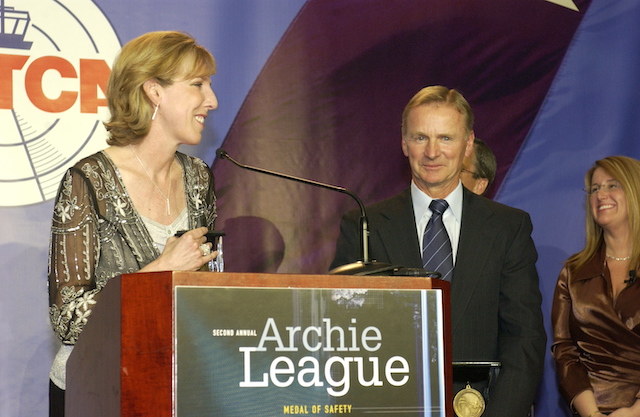
Tower controllers are trained to quickly spot anything that may affect the safe flow of aircraft on and around the airport surface, whether it’s debris on runways, an inbound aircraft with its landing gear up or a plane or airport vehicle mistakenly turning toward an active runway. But a police chase that ends up on airport taxiways? That’s probably not included in any Federal Aviation Administration handbook on what to expect in your field of vision from the tower.
But Phoenix controllers Pam Mitchell, Erwin Tobey, and David Tomczak, working a busy Thursday morning traffic push in June, suddenly found themselves with a front-row seat for a real-life episode of “Cops.” A police pursuit took an unexpected turn toward the airport and the driver being chased crashed his truck through a fence and drove onto the taxiways, racing past several aircraft. Immediately, Mitchell, the ground controller, handled the surface traffic, while local controller Tomczak worked the airborne traffic, as this unpredictable and dangerous situation developed moment by moment. Coordinating between ground and local was staff specialist Erwin Tobey. Departures were delayed immediately.
A taxiing America West flight was the first to notice something amiss with the normal routine and asked the tower, “What’s all the rotor, all the helicopters, out there for?” Mitchell replied, “Well, they’re chasing a bad guy. I’m not sure what he did.” Pilot: “On the ground or in the air?” Mitchell: “On the ground.”
For the next several minutes, Mitchell informed curious pilots of what was happening, helped them steer clear of the police activity near the airport fire station, and tried to keep the operation moving and calm. “Southwest, three-fifty-two use caution, there’s a vehicle off the left,” Mitchell said. “That’s the guy they’ve been chasing. Southwest 352 replied, “Holy cow, you gotta be kidding me.” Mitchell: “I am not kidding you.” Southwest 352: “Yeah, I see him go.” Mitchell: “Yeah, everybody on the taxiway just hold position please. Everybody on the taxiway hold position. Cactus eight-forty-one hold your position. Jetlink twenty-three-zero-nine, don’t move please, there’s a vehicle on the chase, moving right by you right now.”
Later, after the suspect was apprehended, the situation turned humorous. An unknown pilot told the tower, “Looks like a good jail term for that guy.” Mitchell replied, “He got onto taxiway echo without a clearance from me. He’s definitely going to jail.” The unknown pilot then answered, “Turn him over here to twenty-two-oh-six; I’ll shoot him.”
Phoenix television reporters who covered the event had praise for the NATCA controllers on the air. Said KNXV-TV: “It was a serious situation, but listening to the tapes, it sounds like the air traffic controllers were using humor to keep things calm. There’s concern, frustration, and even sarcasm involved. There’s two things to keep in mind: nobody was injured and air traffic controllers were able to maintain their cool during a serious situation.”
“This situation, which went on for about 15 minutes, illustrates the teamwork and professionalism of the controllers involved,” said Phoenix Tower NATCA Facility Representative Jerry Johnston. “Snap judgments as to the safe movement of aircraft on the ground and in the air were required as developments unfolded with the truck careening all over the airport. The police were trying to incapacitate the driver and/or the vehicle. All the while, these three controllers calmly worked through one of those days that you just can’t train for.”
Bob Marks, Western Pacific Region Vice President:
“As air traffic controllers, we are trained for the unusual. That includes aircraft emergencies, passenger medical problems, and the like. However, no training can prepare someone for an event like that which occurred at Phoenix Sky Harbor Airport when a police pursuit suddenly burst onto the airport taxiways after a deranged driver crashed his vehicle through the security fence. While the driver of the vehicle dashed madly around the taxiing aircraft, our controllers remained calm and professional, with all three coordinating the response to this situation with one another. These three NATCA members demonstrated the mental toughness the flying public demands from us. They were cool under pressure, even facing demands that were completely unforeseen. In the middle of utter chaos, our three controllers maintained the careful choreography on the ground and in the sky while ensuring safety. Hardly anyone on the ground or in the air knew anything was amiss. The reason is because these controllers did their job under the most extraordinary of circumstances.”
President’s Award: Jesse Fisher, Miami Tower
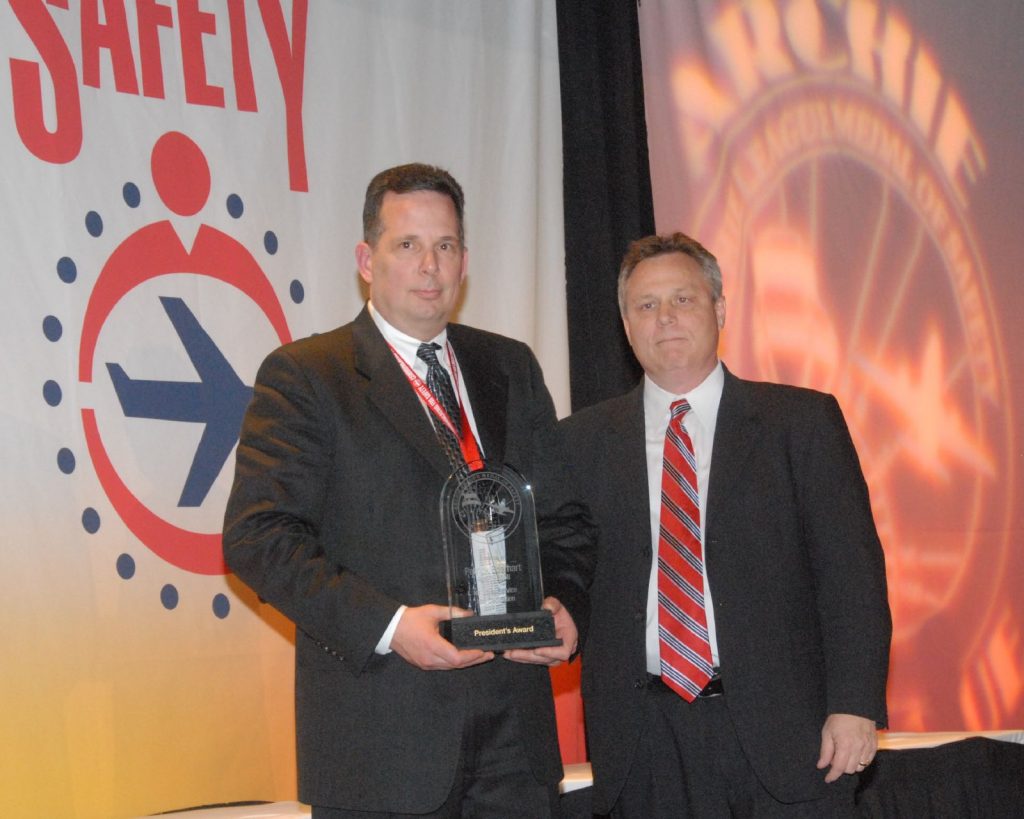
The scenario had all the makings of a disaster. It was dark. Traffic volume was heavy and complex. The local control positions inside Miami Tower were combined. The radio frequency was congested. The weather was marginal. Visibility was poor. And the airport’s Airport Movement Area Safety System was in limited mode, meaning it was not providing controllers with aural or visual alarms to signal potential runway incidents.
Controllers in the tower were using Runways 26 Right (26R) and 27 for arrivals, using staggered instrument approaches, and departing on Runways 26 Left (26L) and 27. Rain obscured both the movement area and final approach courses. Veteran tower Controller Jesse Fisher was working the Local Control North (LCN) position, combined with the Local Control South position.
A Lockheed L329 Jetstar was on approach to Runway 26R. The pilot checked in with Fisher on the LCN frequency and Fisher cleared him to land on Runway 26R. The pilot acknowledged the clearance and subsequently reported that the runway was in sight.
Meanwhile. American Airlines Flight 2104, a Boeing 737, was taxied into position and holding on Runway 26L, awaiting takeoff clearance, due to in-trail separation with traffic departing Runway 27, and traffic crossing the runway. Additionally, American Airlines Flight 1917, a Boeing 757, which had just arrived on Runway 26R, was instructed to cross Runway 26L and was advised that traffic (American 2104) was holding in position.
As Fisher scanned the movement area and the final approach courses, he saw the Jetstar on short final approach, at approximately 200 feet off the ground, lined up with the wrong runway – 26L instead of 26R – with American 2104 holding in position and American 1917 crossing the runway downfield.
Fisher immediately instructed the Jetstar to execute a go-around and the pilot complied. He appeared to overfly American 2104 by approximately 100 feet and American 1917 by about 400 feet.
Upon hearing and seeing what was happening, the pilot of American 1917 keyed the radio microphone and uttered an expletive. Shortly thereafter, an unidentified aircraft waiting in line for departure off Runway 26L keyed the mike and said, “Good job, tower!” Another unidentified aircraft waiting in line for departure then transmitted, “Nice save, tower!” When American 2104 was cleared for takeoff, the pilot’s reply was, “Hey, a huge thanks from us.”
Fisher’s quick instruction to the Jetstar pilot was even more important considering that Runway 26L has no displaced threshold, meaning the distance between where American 2104 was holding in position and the point where the Jetstar would have touched down is indiscernible.
“One of the key elements that make Jesse’s actions so outstanding is the fact that Runway 26R and 26L are in such close proximity, with only 800 feet between the center lines,” Miami Tower NATCA Facility Representative Jim Marinitti said.
“Additionally, when you factor in that the tower is located on the opposite side of the airport from the west final approach courses – over two miles away – and that the arrival aircraft appeared to be on the correct final until very close to the airport, it makes it that much more remarkable that Jesse was able to identify this pilot error and take action in time to prevent a catastrophe at night with limited visibility.”
Fisher has worked at Miami Tower since 1991. Adds Marinitti: “It is not a cliché to say that an untold number of passengers arrived home safely on this day due to, but completely unaware of, Jesse’s outstanding situational awareness and heroics on the job. Jesse’s valiant performance truly exemplifies what makes our aviation system the safest in – and the envy of – the world.”
Andy Cantwell, Southern Regional Vice President:
“I have personally known Jesse for 15 years and have always considered him to be the consummate professional. On March 18, Jesse once again demonstrated his professionalism and expertise. His attention to detail and quick reactions prevented a foreign general aviation aircraft from landing on a runway that was occupied by a B737 awaiting a takeoff clearance and a B757 crossing the runway downfield. On that night, Jesse was working combined Local Control positions during a period of heavy traffic and marginal weather conditions. The centerlines of Runways 26 left and right are separated by only 800 feet. The runway threshold is approximately two miles away from the tower and it is difficult to determine if arriving aircraft are lined up for the correct runway during daylight and good weather conditions. Fortunately, Jesse did notice that the arriving aircraft was lined up with the wrong runway and quickly issued instructions that prevented a major disaster. In addition to darkness and poor weather conditions, the Airport Movement Area Safety System (AMASS), was operating in limited mode and did not provide any aural or visual alarms of the impending disaster Having worked at MIA for over 24 years, I am intimately aware of just how remarkable Jesse’s actions were on that night. The fact that several pilots commented on the situation means they were also aware that Jesse averted a deadly situation. Jesse believes he was simply doing his job. He did his job perfectly on that night.”
BELOW: Watch the award presentation.
BELOW: Watch and listen to highlights from this save event.
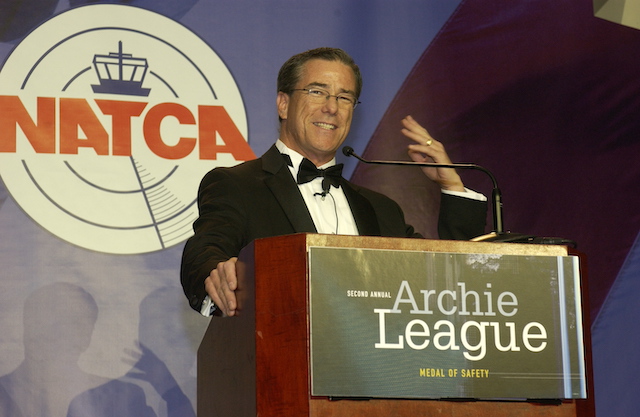
Honorable Mention
Eastern Region
Jude Juneau, New York Center
John Reyes, Teterboro Tower
Patrick Sartori, Potomac TRACON
Jeffrey Steiner, New York Center
Brian Targer, New York TRACON
Great Lakes Region
David Gustafson, Rockford Tower
Wade Kennedy, Cleveland Center
Anita Lutz, Youngstown Tower
Steven Meitz, Chicago Center
Connie Ritchie, Indianapolis Tower
Doug Strain, Indianapolis Tower
Steve Swoboda, Dayton Tower
Aline Trussoni, Madison Tower
Steve Weidner, Minneapolis Center
New England Region
Jay Bowers, Boston Center
Northwest Mountain Region
Jack Armstrong, Denver Center
John Paul “JP” Coleman, Salt Lake Center
Randall “Leif” Erekson, Pueblo Tower
Rob Ryan, Salt Lake Center
Southern Region
Jerry Clarke, Gulfport Tower
Shawn Clarke, Gulfport Tower
Beverly Jones, Louisville Standiford Tower
George Martin, Gulfport Tower
Cathy Whitney, Gulfport Tower
Southwest Region
Rob Gill, Tulsa Tower
Idalia Pulido, Corpus Christi Tower
Award of Special Recognition: Facilities That Were the “Eye in the Storms”
This year, NATCA is including those air traffic control facilities in its awards recognition which served as the “Eye in the Storm” by maintaining the National Airspace System during a tropical storm season that produced 26 named storms, 14 of which became deadly hurricanes. While these swirling masses of destruction devastated the homes and lives of hundreds of air traffic controllers, NATCA members put the safety of the public first by displaying an extraordinary level of skill and selflessness during the evacuation, relief and recovery efforts.
Many of the air traffic control facilities handled large volumes of traffic before the arrival of the hurricanes in order to ensure the area’s occupants were safely evacuated. In Beaumont, Texas, some controllers worked 19 consecutive hours, putting their safety last, knowing their families may have to evacuate without them. Likewise, after the storms hit, controllers returned to the facility to assist in rescue operation despite their own personal losses. At New Orleans Tower, of the 18 controllers, 10 had no homes left and many worked as long as 20 straight hours to assist in the relief efforts, with many controllers sleeping on cots at the facility. At the height of the rescue operation, this facility ran about four times the number of operations it usually has in a normal day.
Facilities hugging the Gulf Coast all worked a record level of operations. At Baton Rouge Tower, controllers used taxiways as parking lots for helicopters, as they juggled around 922 daily operations, about three times as much as their usual 300-350. One hour west of Baton Rouge at Lafayette Tower, controllers who normally worked around 325 operations a day were now handling 1,200 in the days after Hurricane Katrina. Not only were controllers handling a wide range and large volume of military aircraft, but they were also interacting with pilots who were unfamiliar with the airfield.
The 2005 hurricane season is one that this nation will never forget. And NATCA didn’t want to forget the efforts of its members who worked diligently to keep the NAS operational. These controllers rose above the ordinary call to duty and demonstrated a level of skill, courage and professionalism in challenging and chaotic times, which ultimately helped save the lives of many sick, injured and elderly evacuees. Their efforts are an outstanding example of the lengths NATCA members will go to in order to protect the safety of their system and their communities.
While the union is aware of the huge outpouring of humanitarian relief its membership provided, including collecting over $100,000 to assist those in need, opening their homes to storm victims and delivering essential supplies hundreds of miles away, the Archie League Award focuses on aviation safety. This award acknowledges those facilities which helped uphold controllers’ high sense of integrity and safety by keeping the system operational by putting the needs of the public ahead of their own to ensure the safety of the air traffic system. And the winners are:
Award Recipients
Baton Rouge Tower – Hurricane Katrina
Beaumont-Port Arthur Tower – Hurricane Rita
Gulfport Tower – Hurricane Katrina
Jackson Tower – Hurricane Katrina
Lafayette Tower – Hurricane Katrina and Hurricane Rita
Lake Charles Tower – Hurricane Rita
Meridian RAPCON Tower – Hurricane Katrina
Mobile Tower – Hurricane Katrina
New Orleans Lakefront Tower – Hurricane Katrina
New Orleans-Louis Armstrong International Tower – Hurricane Katrina
Honorable Mentions
D.W. Hooks Tower – Hurricane Rita
Ft. Lauderdale Tower – Hurricane Wilma
Ft. Lauderdale Executive Tower – Hurricane Wilma
Fort Myers Regional Southwest Tower – Hurricane Wilma
Ft. Pierce Tower – Hurricane Wilma
Houston Center – Hurricane Rita
Houston Hobby Tower – Hurricane Rita
Houston Intercontinental Tower – Hurricane Rita
Houston TRACON – Hurricane Rita
Miami Center – Hurricane Wilma
Miami Tower – Hurricane Wilma
Palm Beach Tower – Hurricane Wilma
Tamiami Tower – Hurricane Wilma
Vero Beach Tower – Hurricane Wilma
Photo Album: The 2nd Annual Archie League Medal of Safety Awards Banquet
View photo album here.


